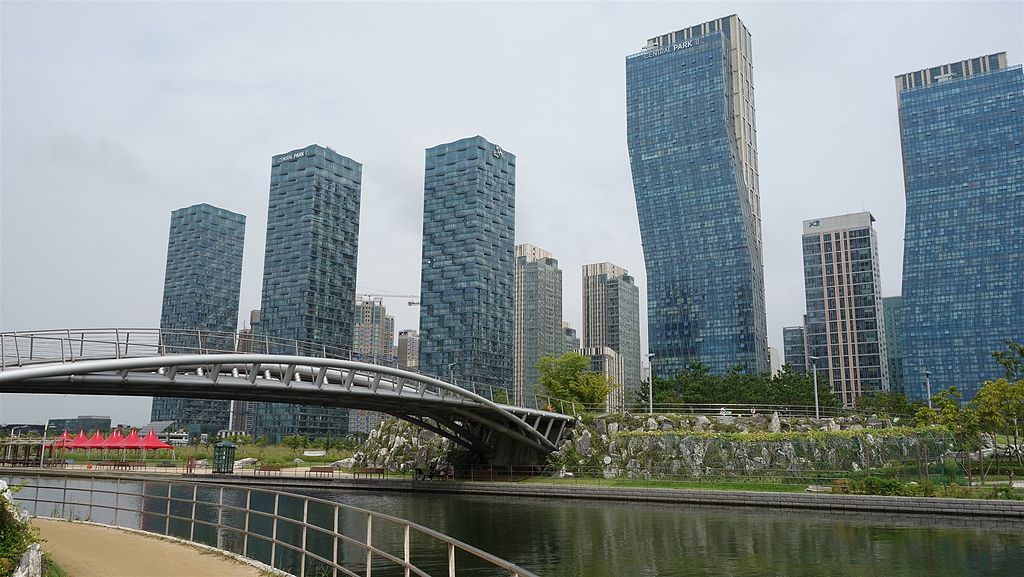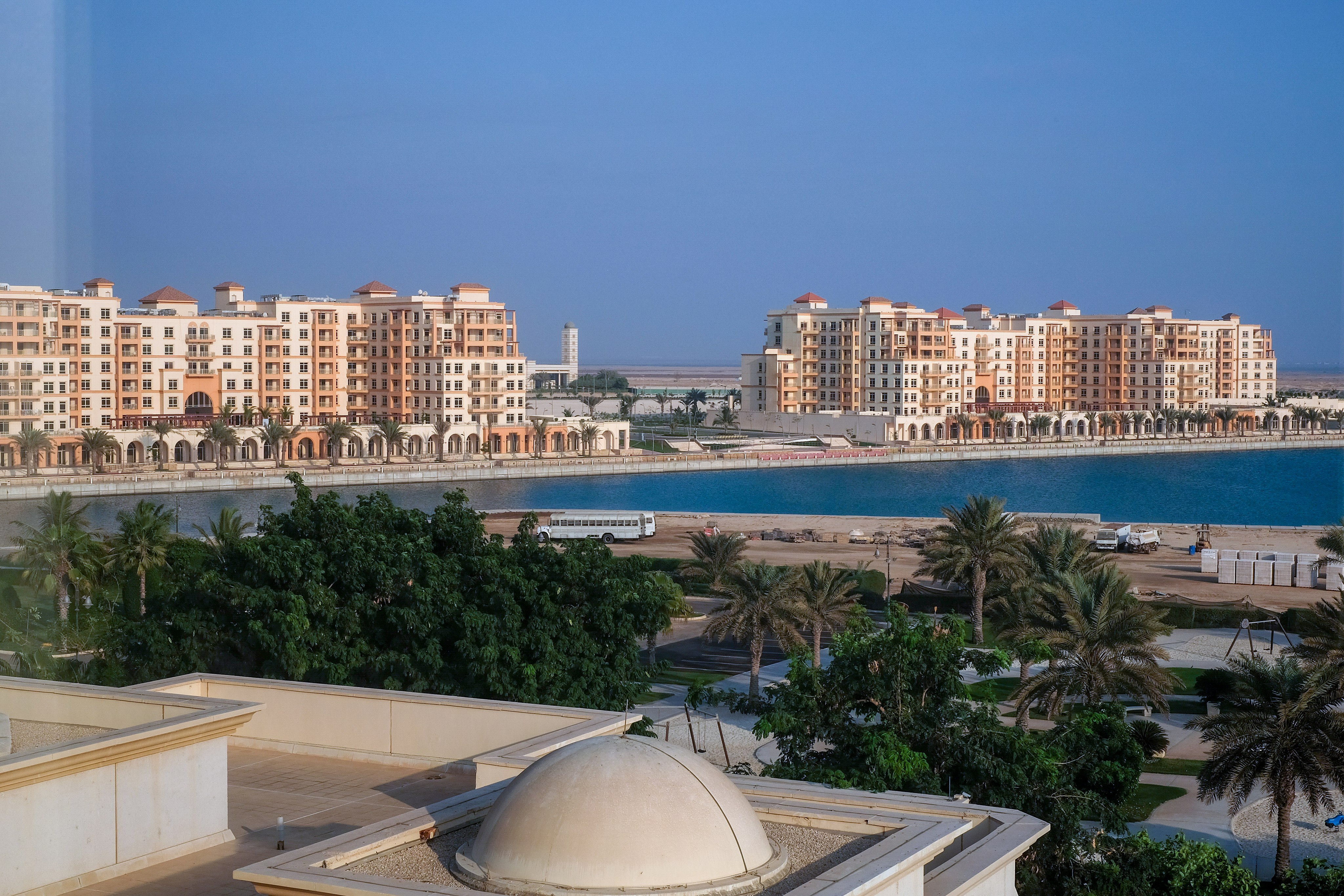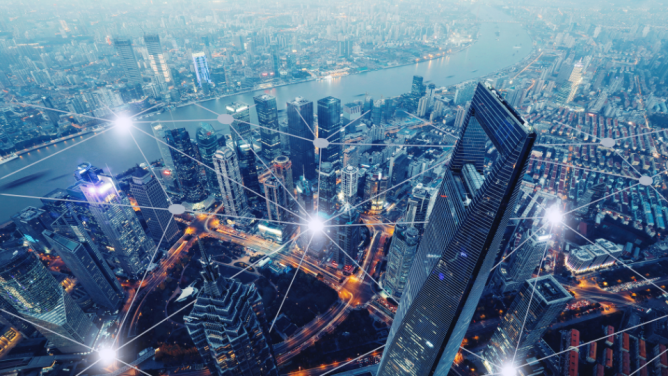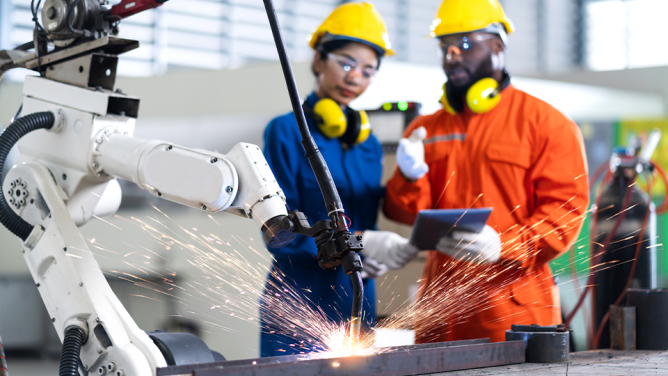
Songdo, the Powerpoint city
An hour outside of Seoul, Songdo positions itself as the ultra-connected and sustainable city par excellence. With an artificial island as its foundations, the impact it has in terms of sustainability still remains the promise of the two private enterprises at the project’s origin, the Korean construction giant Posco and the American real estate promoter Gale, much more so than the fruit of scientific evidence. “In the past the only people who dared to build a city from scratch were builders like le Corbusier; today the task falls upon the likes of McKinsey Consultants or PricewaterhouseCoopers”, observes Daniel Hook in The Future Cities when talking about Songdo, where he sees the influence of prestigious consultancy firms in the architecture.
With its glass skyscrapers, Songdo was conceived from the beginning to become an international economic hub. On paper, it reads like a brochure for the ideal modern city: covered with sensors, it appears more intelligent because it is continuously monitoring the city’s functionalities according to how they are being used. Transportation is provided by infrastructures that are capable of managing high volume traffic and connecting destinations with populations most likely to live in the skyscrapers. These populations however are less numerous than planners initially expected: the city that was supposed to rival Soeul and its 18 million inhabitants has so far only welcomed 250,000 people. Among the inhabitants of this city built over a ten year period, only 4,500 are foreign. Especially for them, the city is planning to build a park and promenade on the waterfront. “When walking around Songdo, one doesn’t get the impression that it’s a ghost town as journalists referred to it in its first years,” the newspaper Liberation tells us, ”but you don’t really see a lot of people”.
Masdar, formerly a city, now a mirage
Initially, Masdar (« source » in Arab) was supposed to be completed by 2016 and showcase the United Arab Emirates’ new ecological aspirations in the field of renewable energy : universities, prestigious corporate headquarters, resilient constructions, with low energy consumption and new aesthetics. These were all meant to make the petroleum giant shine under a new light. However the sovereign fund that oversees the project, Mubadala, had to downscale its ambitions following the financial crisis of 2008. Where Masdar was supposed to welcome 90,000 residents, whereas it is currently home to 2,000 lonely souls – of whom the vast majority are students living in close proximity to the Institute of Science and Technology. The project’s sustainability goals have also taken a turn for the worse, as the city’s energy mostly relies on petroleum based energy.
Part of the initial plan conceived by Norman Foster Associates does exist, just a few kilometers from the Abu Dhabi airport, on a surface that covers 150,000 square meters (one and a half the size of Paris). “When night falls, 300 or so students from the university (50% of whom are Emiratis) wonder about this ghost town, lit by the occasional bar-restaurant and a sleepy sporting facility”, as told by Le Monde in un reportage lunaire (“report from the Moon”). Nicolai Ouroussoff of the New York Times is even less generous, qualifying the city as the ultimate gated community, and the realization of yet another global phenomenon: the growing isolation of global technological enclaves and shapeless ghettos where questions of sustainability are all but irrelevant”. According to him, the city’s public transportation system is always empty.
Forest City: hanging gardens and suspended ambitions
Forest City was born several hundred meters from the coast of Singapore. Built on four artificial islands, this mega real estate project sells itself as a green paradise for 700,000 inhabitants, mostly Chinese. Here, traffic is enclosed inside of massive building structures, leaving the city on the surface entirely to vegetation, conceived especially for asthmatic pedestrians. More than 100 million dollars have been invested, mostly by Chinese investors and multinational banks (Deutsche Bank, Microsoft), for whom the project also represents an important real estate investment.
The only problem is that the Malaysian Prime Minster, Mohamad Mahathir, has just put a halt to the construction of Forest City’s hanging gardens. In fact the territory has become the object of mounting geopolitical tensions. “The fact that it is a city owned and run by private sector entities, where corporations provide security for the city’s inhabitants raises extra-territorial questions for Malaysia”, noted the new city specialist Sarah Moser during a conference at McGill University. If the objective is primarily focused on real estate as stated, in her eyes Forest City represents China’s expansionist tendencies, for which this new city serves as a medium.
Putrajaya and Cyberjaya, each city has a purpose
Putrajaya is the new administrative capital of Malaysia. At 20 km south of Kuala Lumpur, to which it is linked via a high speed train, this city represents a rupture with the historical capital, with its urban chaos and western architecture. Far from Kuala Lumpur’s mirrored skyscrapers, Putrajaya’s intentional monumentality is inspired by the history of Islam. Its architectural choices are part of a larger will to affirm the country’s Muslim identity. Some, such as Sarah Moser, have noted that this political function also means separation from non-Muslim demographics. 98% of the city’s population is Muslim, surely because the city refuses to allow minority religions to set up places of worship (Hindi and Christian). Dogs and pigs are strictly forbidden in the new federal capital, and the administrative functions of official buildings do not allow for any other types of activity.
It is in distant Cyberjaya that Malaysia’s economic ambitions are being played out, with the dream of becoming an Asian Silicon Valley. The idea of creating a vocationally digital city came from a study conducted by McKinsey consultants in 1995. However the late 1990s crisis delayed the project. Today, both function-based cities face the discord between their initial ambitions and today’s reality, where their attractiveness to business and citizens is much lower than expected.
>> SEE ALSO: A Malaysian Insta-City Becomes a Flash Point for Chinese Colonialism — and Capital Flight
King Abdullah Economic City, where citizens are investors
King Abdallah’s economic city is better known under the acronym KAEC (King Abdullah Economic City). Located on the Red Sea coast, about 50 km south of Rabigh, and 100km north of Djeddah, it spreads over 180 km² and is set to become the world’s fifth largest port. For the time being it only houses about 4,000 inhabitants, but is expecting 2 million more to settle in by 2035. The city’s mayor is also its CEO, and is responsible for managing the city like a business. As such KAEC shares have been available on the Saudi stock exchange since the project’s beginnings in 2006 – the largest in investment terms for a new city.
The King Abdallah ben Abdelaziz Al Saoud began the project in 2005 as a profitable real estate investment project but also as a laboratory to test moving the country towards more liberal economic and moral principles. In KAEC women have been driving and wearing colorful abayas for several years now, both of which are restricted in the rest of the country. Work space and restaurant segregation according to gender is also less strict in KAEC, and the religious police are less present.



